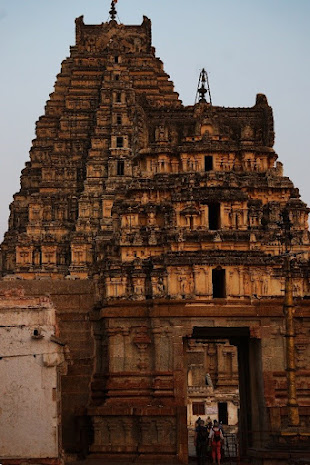PAINTINGS OF VIRUPAKSHA TEMPLE
Site
name: Virupaksha Temple, Bellari,
Karnataka
Article written by: Shreeya
Rawat
PAINTINGS
OF VIRUPAKSHA TEMPLE
The Virupaksha Temple or the Lokeshwara Temple dedicated to Lord Shiva is situated at Hampi in the Bellari district of Karnataka. ‘Virupa’ means ‘no form’, and ‘aksha’ means ‘eyes’, hence Virupaksha, a name for Lord Shiva, literally means eyes without any form. The temple is built in the Dravidian style of architecture and is located along the southern bank of the Tungabhadra River. The temple is a part of the Group of Monuments at Hampi, designated as a UNESCO World Heritage Site.
Lakkan Dandesha, a Nayaka chieftain under the rule of Deva Raya II of the Vijayanagara Empire built this temple in the 7th century C.E. Later additions were made to the temple structure during the late Chalukyan and Hoysala periods. It is one of the oldest living temples in Hampi.
The ceiling of the ranga mandapa of the temple houses wall paintings made in tempera technique. These paintings are arranged in rectangular panels having richly decorated borders. The theme depicted in the paintings are mainly from the puranas and epics. These paintings belong to the Vijayanagara School of paintings which is a combination of the Chalukya, Chola and Pandya styles. Many of them have faded considerably or deteriorated in the course of time and only panels on the central portion of the ranga mandapa are still visible. Some of them have been restored in recent years.
The paintings on the topmost panel of the western section near the garbhagriha consist of the Trimurtis – Brahma, the creator, Vishnu, the preserver and Mahesh, the destroyer, each of them sitting along with their consorts. Exquisite designs on the clothes of gods and goddesses, intricate borders and vibrant colours dominate these paintings.
The scene above portrays the grand wedding celebration of Shiva and Parvati. Several Hindu gods can be seen attending the wedding including Brahma and Vishnu. Shiva is depicted in the centre of the painting holding the hands of Parvati. Standing behind Parvati are her parents, Himavata and Menavati along with female attendants.
One of the panels in the middle section narrates a scene based on Shiva Purana where Kamadeva, the God of Love, is riding his chariot and striking his kamabanas at the meditating Shiva to arouse his desire for Parvati, who is shown standing in front of him with folded hands.
The other panel depict the ‘Tripurantaka’, an incarnation of Shiva who destroyed the three aerial cities of the sons of Tarakasura. As per the boon given by Brahma, each of the three sons were granted with an aerial city that revolved around the earth. This helped the demons to gain immense power and wrecked havoc on the universe. Thus, Shiva took the form of ‘Tripurari’ or ‘Tripurantaka’ to destroy the three aerial cities when they converged in a single line. Shiva is shown riding a chariot, pulling the arrow on the bow and aiming towards the three cities, represented in the form of three circles. In the painting, he is depicted as wearing a blue dhoti and holding a damaru in one of his hands. He is surrounded by naginis behind him. Shiva’s chariot is pulled by the four Vedas portrayed as horses.
Another such painting illustrates the stringing of the mighty bow of Shiva by Rama that helped him win Sita as his bride. The painting portrays Rama at the centre of the painting is lifting the bow in his hand and pulling its arrow. He is accompanied by Sita holding a garland to his right side and Lakshmana to his left.
On the other hand, the classical scene of Mahabharata portrays the famous archery test of Arjuna hitting the fast-moving piscine target which helped him win the hand of Draupadi.
The painting has signs of deterioration over a long period of time. Soot deposition indicating the use of oil lamps have been observed which inhibit the aesthetic beauty of the painted ceiling.
REFERENCES
- https://www.tcrc.in/wp-content/uploads/2020/07/V3i6-Article_1_AP.pdf
- https://yatrikaone.com/hampi/hampi-virupaksha-temple-murals/
- https://www.newindianexpress.com/opinions/2021/jun/10/the-only-surviving-vijayanagara-paintings-in-hampi-2313967.html
- https://www.profraguram.com/musings--reflections/entrancing-murals-of-hampi
- https://sreenivasaraos.com/tag/ceiling-paintings/












Comments
Post a Comment